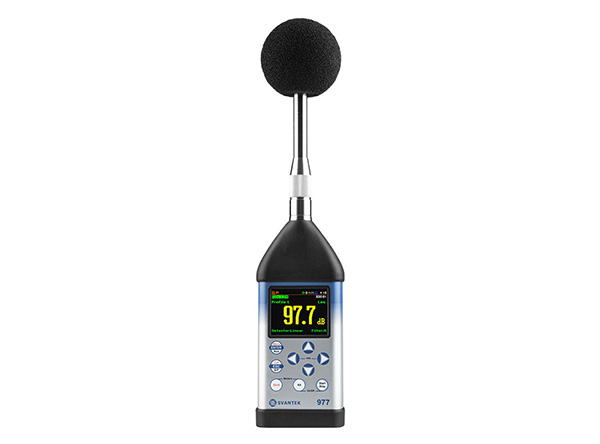
SVAN 977A is a fully digital Level 1 sound and vibration analyzer designed specifically for general acoustic and vibration, environmental noise, occupational health, and building acoustic measurements.
This instrument has three acoustic and vibration configuration files that can be customized by the user, each of which uses independently defined frequency filters and RMS detector time constants for parallel measurement. Each configuration file provides a large number of results (such as SPL, Leq, Sel, Lden, LEPd, Ltm3, Ltm5, Lnn, LR15, LR60, Ovl, peak, maximum, and minimum values for sound measurements, and RMS, Ovl, peak, P-P for vibration measurements).
The advanced time history of each configuration is recorded on the SD card installed at the bottom of the instrument panel, providing complete information about the measurement signal, and can be easily downloaded to any PC through USB interface and SvanPC++software.
RT60 reverberation time measurement

- RT60 analysis is an optional feature of SVAN 977, which provides reverberation time calculation for the 1/1 octave frequency band (from 63 Hz to 16 kHz) or 1/3 octave frequency band (from 50 Hz to 20 kHz) and three total RMS levels (A, C, and Z weights). The entire measurement process and calculations implemented in SVAN 977 comply with the ISO 3382 standard.
- Using SVAN 977, the reverberation time of a room can be obtained through two measurement methods: pulse response method (pulse) and interruption noise method (attenuation). The choice of method depends on the type of sound source used. The pulse method is designed to use a pulse sound source (such as pistol shooting, petal explosion) for measurement, while the attenuation rule is used to measure the noise source (usually pink noise) when a room is excited by wide or narrow band sound.
The reverberation time analysis applied in the instrument consists of two parts:
- The measurement part that records the acoustic response of the room during the measurement period.
- The calculation section for calculating the reverberation time (EDT, RT20, RT30, and RTUser) of the measurement room response.
Telecommunication

Bluetooth for mobile applications ® interface
Bluetooth built-in to SV 977 sound level meter ® The interface, along with smartphone applications, extends the measurement capabilities of all functions provided by smartphones. Smartphone applications help users preview results in the form of time history graphs and numerical values. The size of mobile device displays makes it convenient to display spectral views (such as one-third octave analysis).
For architectural acoustics, smartphone applications help users calculate sound insulation effects according to ISO 16283. The sound insulation effect is displayed on the display screen and displayed in a report format that meets ISO requirements.
Technical specifications
| Compliant with standards | Type 1: IEC 61672-1:2013; Level 1: IEC 61260-1:2014 |
| Weighting filter | A,B,C,Z,LF,U,AU,HP,HP1,HP3,HP10,Vel1,Vel3,Vel10,VelMF,Dil1,Dil3,Dil10和Whweighting filter。 |
| Time constant | Slow, fast, pulse |
| Microphone | Microtech Gefell MK 255,50 mV/Pa,Pre polarized 1/2 ″ condenser microphone |
| Linear operating range | 23 dBA RMS ÷ 140 dBA Peak(According toIEC 61672) |
| Frequency range | 3 Hz ÷ 20 kHz (Up to40Hz) |
| Total dynamic measurement range | 16 dBA RMS ÷ 140 dBA Peak(Typical from background noise to highest level) |
| Local noise level | <16 dBA RMS |
| Analyzer | 1/1 octave or optional 1/3 octave analysis, up to 40.0 kHz frequency band compliant with Level 1: IEC 61260-1 FFT analysis 1600 lines, up to 40 kHz frequency band (option) Synchronous measurement of speed and vibration (optional) RT 60 reverberation time measurement (optional) |
| Display | Ultra high contrast (10000:1) OLED 2.4 "inch color screen (320 × 240 pixels) |
| Size/Weight | 343 × 79 × 39 mm / 0.6kg(Including battery) |
Our company's policy is to continuously innovate and develop our products.
Therefore, we reserve the right to change product specifications without prior notice.





